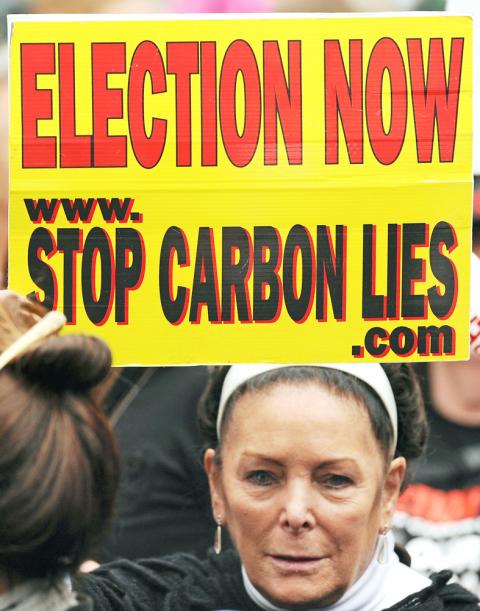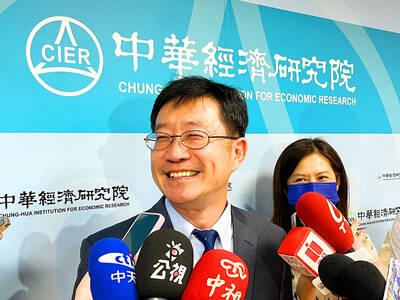Australia yesterday joined a growing number of nations to impose a price on carbon emissions across its US$1.4 trillion economy in a bitterly contested reform that offers trading opportunities for banks and polluters, but may cost the prime minister her job.
Australia’s biggest polluters, from coal-fired power stations to smelters, will initially pay A$23 (US$23) per tonne of carbon dioxide emitted, more than twice the cost of carbon pollution in the EU, currently trading around 8.15 euros (US$10) a tonne.
The economic pain will be dulled by billions of dollars in sweeteners for businesses and voters to minimize the impact on costs, with the consumer price index forecast to rise by an extra 0.7 percentage point in the 2012-2013 fiscal year.

Photo: AFP
The scheme allows emissions trading from 2015, when polluters and investors will be able to buy overseas carbon offsets, or ultimately trade with schemes in Europe, New Zealand and possibly those planned in South Korea and China.
Australian Prime Minister Julia Gillard’s minority government says the plan is needed to fight climate change and curb greenhouse gas pollution. Australia has among the world’s highest per capita carbon emissions due to its reliance on coal-fired power stations.
Yet even as it starts, the scheme’s future is in doubt. The conservative opposition has vowed to repeal it if they win power in elections due by late next year and have whipped up a scare campaign saying the tax will cost jobs and hurt the economy.
Gillard, her poll ratings near record lows and her Labor party heading for a heavy election defeat, hopes that the campaign will quickly run out of steam once the scheme starts.
“Cats will still purr, dogs will still bark,” Gillard said after opposition leader Tony Abbott’s visit to an animal shelter to warn of higher electricity prices on charities. “The leader of the opposition’s fear campaign will collide with the truth.”
However, voters remain angry that Gillard broke a 2010 election promise not to introduce a carbon tax and many observers think government hopes of a resurgence after July 1 are unlikely.
“The damage is already done,” political analyst Nick Economou at Monash University said.
“What will be interesting is whether Labor takes the lemming option and follows her over the cliff, or whether it decides that she is the cause of their problems and has to go,” he said.
A poll by the respected Lowy Institute think tank found 63 percent of voters oppose the carbon scheme.
Many big polluters, such as miners, also remain vehemently opposed and uncertainty over its future is crimping investment in the power sector.
UBS has cut its earnings estimates for global mining houses BHP Billiton and Rio Tinto by between 3 and 4 percent ahead of the carbon tax and another tax on mining profits also due to start yesterday.
The Australian carbon scheme is the product of years of fierce bargaining with business and political parties.
It will initially cover just under 300 companies and councils that comprise about 60 percent of the nation’s roughly 550 million tonnes of carbon dioxide.
For the first three years, polluters will pay a fixed price for carbon emissions, reaching A$25.40 a tonne in the final year.
From July 2015, emissions trading with regular auctioning of pollution permits will start, along with rules that allow polluters to buy overseas emission reduction offsets, such as Certified Emission Reductions, part of the UN’s Kyoto Protocol climate pact.
A floor of A$15 a tonne and a cap of A$20 above the expected international price will run till 2018.

IN THE AIR: While most companies said they were committed to North American operations, some added that production and costs would depend on the outcome of a US trade probe Leading local contract electronics makers Wistron Corp (緯創), Quanta Computer Inc (廣達), Inventec Corp (英業達) and Compal Electronics Inc (仁寶) are to maintain their North American expansion plans, despite Washington’s 20 percent tariff on Taiwanese goods. Wistron said it has long maintained a presence in the US, while distributing production across Taiwan, North America, Southeast Asia and Europe. The company is in talks with customers to align capacity with their site preferences, a company official told the Taipei Times by telephone on Friday. The company is still in talks with clients over who would bear the tariff costs, with the outcome pending further

WEAKER ACTIVITY: The sharpest deterioration was seen in the electronics and optical components sector, with the production index falling 13.2 points to 44.5 Taiwan’s manufacturing sector last month contracted for a second consecutive month, with the purchasing managers’ index (PMI) slipping to 48, reflecting ongoing caution over trade uncertainties, the Chung-Hua Institution for Economic Research (CIER, 中華經濟研究院) said yesterday. The decline reflects growing caution among companies amid uncertainty surrounding US tariffs, semiconductor duties and automotive import levies, and it is also likely linked to fading front-loading activity, CIER president Lien Hsien-ming (連賢明) said. “Some clients have started shifting orders to Southeast Asian countries where tariff regimes are already clear,” Lien told a news conference. Firms across the supply chain are also lowering stock levels to mitigate

NEGOTIATIONS: Semiconductors play an outsized role in Taiwan’s industrial and economic development and are a major driver of the Taiwan-US trade imbalance With US President Donald Trump threatening to impose tariffs on semiconductors, Taiwan is expected to face a significant challenge, as information and communications technology (ICT) products account for more than 70 percent of its exports to the US, Chung-Hua Institution for Economic Research (CIER, 中華經濟研究院) president Lien Hsien-ming (連賢明) said on Friday. Compared with other countries, semiconductors play a disproportionately large role in Taiwan’s industrial and economic development, Lien said. As the sixth-largest contributor to the US trade deficit, Taiwan recorded a US$73.9 billion trade surplus with the US last year — up from US$47.8 billion in 2023 — driven by strong

RESHAPING COMMERCE: Major industrialized economies accepted 15 percent duties on their products, while charges on items from Mexico, Canada and China are even bigger US President Donald Trump has unveiled a slew of new tariffs that boosted the average US rate on goods from across the world, forging ahead with his turbulent effort to reshape international commerce. The baseline rates for many trading partners remain unchanged at 10 percent from the duties Trump imposed in April, easing the worst fears of investors after the president had previously said they could double. Yet his move to raise tariffs on some Canadian goods to 35 percent threatens to inject fresh tensions into an already strained relationship, while nations such as Switzerland and New Zealand also saw increased